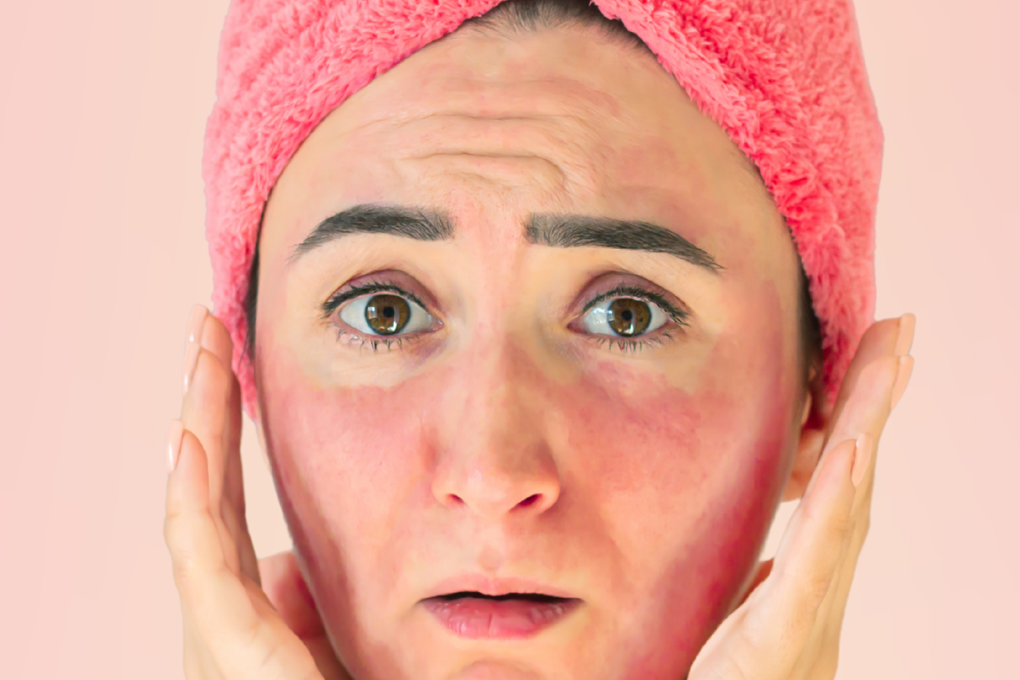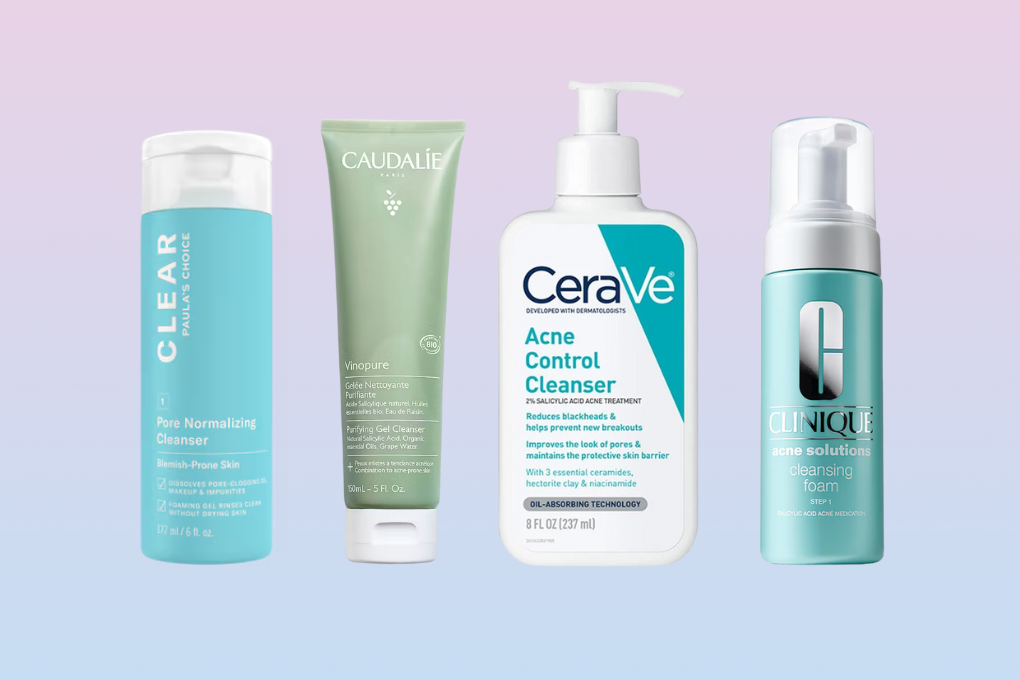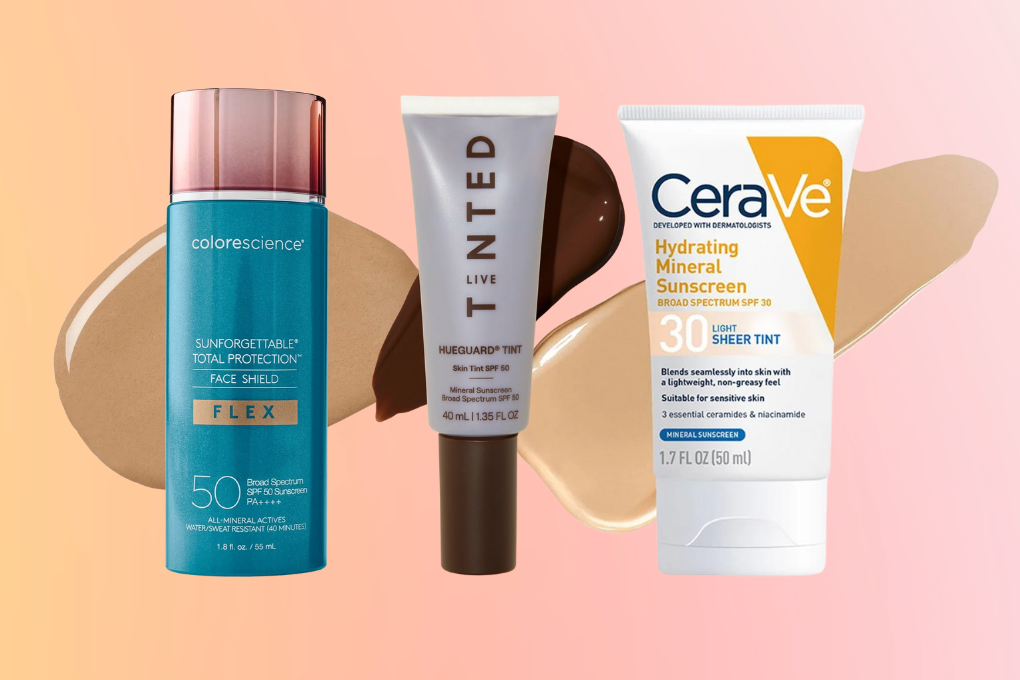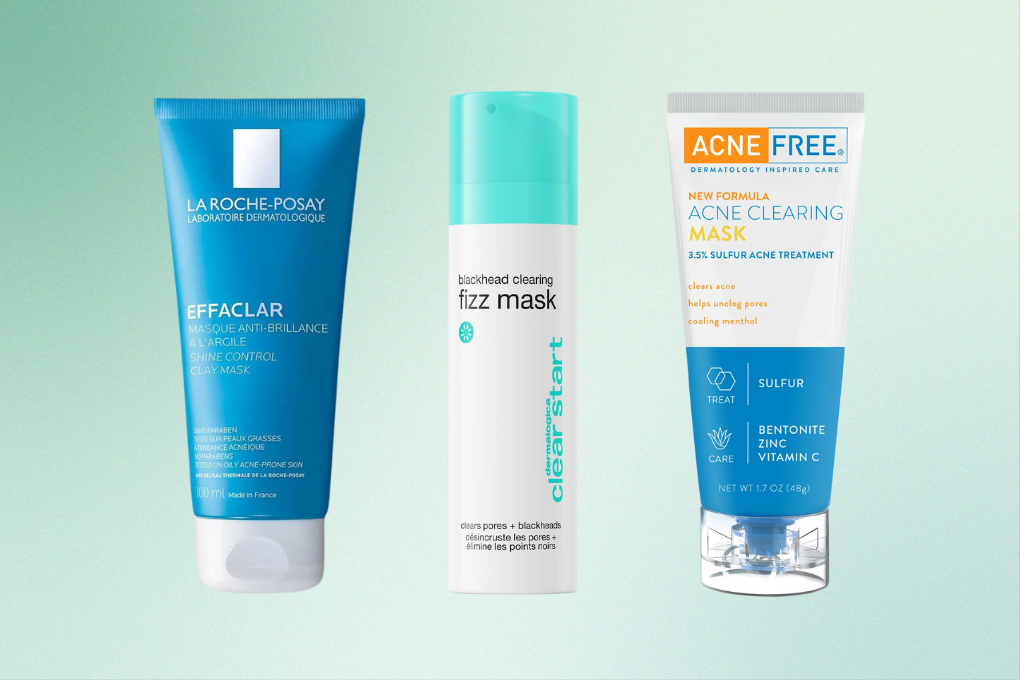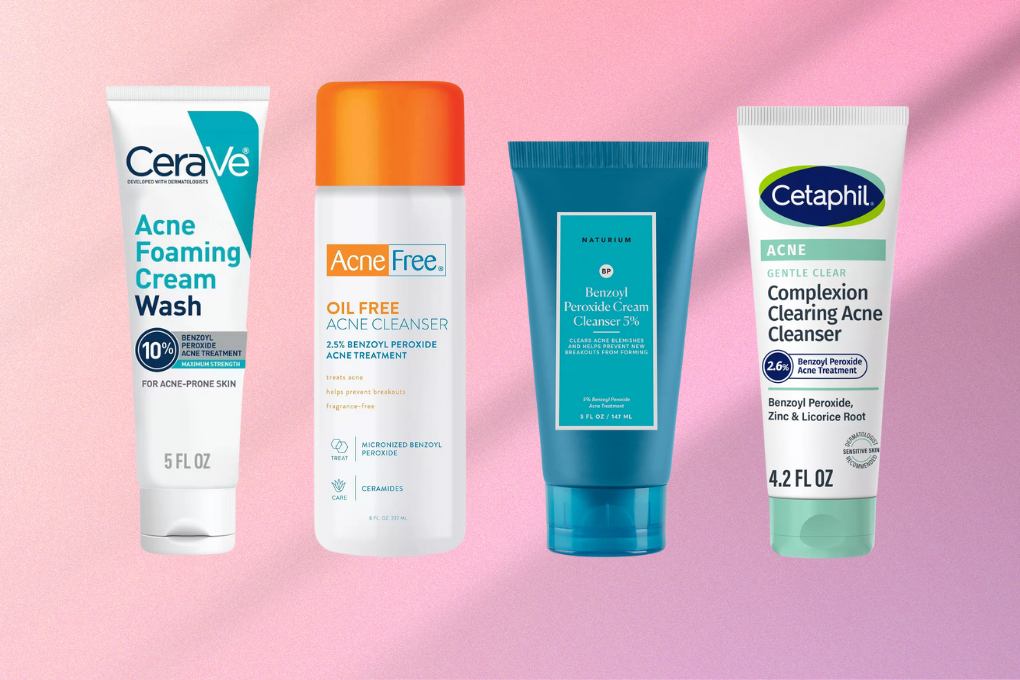- How Does Benzoyl Peroxide Work?
- What Does Benzoyl Peroxide Do To Pimples?
- What Is Benzoyl Peroxide Good For?
- Is Benzoyl Peroxide Over The Counter?
- Benzoyl Peroxide Side Effects
- Does Benzoyl Peroxide Cause Purging?
- Will Benzoyl Peroxide Help Blackheads?
- Does Benzoyl Peroxide Bleach Clothes?
- How To Use Benzoyl Peroxide
- Prescription Strength Benzoyl Peroxide
Ready to dive into the world of benzoyl peroxide? This trusty compound has been at the acne-fighting forefront for a long time, but there’s so much more beneath its surface.
Benzoyl peroxide was first used as a topical antiseptic in the early twentieth century, but it was not until 1965 that the first benzoyl peroxide product was introduced in the United States to treat acne.
Since then, most of us have encountered benzoyl peroxide at some point in our skincare journey. Known for its powerful acne-fighting properties, it remains one of the most commonly used treatments for acne.
How Does Benzoyl Peroxide Work?
Benzoyl peroxide is a type of peroxide (like the hydrogen peroxide that may be sitting in your medicine cabinet), which means that its molecular structure has an unstable bond between two oxygen atoms. When benzoyl peroxide comes in contact with your skin the bond breaks down, releasing oxygen.
Inflammatory acne-causing bacteria, primarily Cutibacterium acnes (C. acnes), are anaerobic, meaning they do not like oxygen-rich environments. When benzoyl peroxide ushers in that oxygen, it essentially suffocates these harmful microorganisms. Unlike antibiotics, benzoyl does not contribute to antibiotic-resistant bacteria.
But how is this different from hydrogen peroxide, you ask? While both are peroxides, hydrogen peroxide is too harsh to use on the skin, and benzoyl peroxide is specifically tailored for acne as it is able to penetrate and target the oily environments of our pores more effectively.
What Does Benzoyl Peroxide Do To Pimples?
Pimples are the culmination of trapped sebum (the oil produced by the skin), bacteria, and inflammation. When a pore gets clogged with sebum and dead skin cells, bacteria seize the opportunity to feed on the sebum, and our body reacts with inflammation, and suddenly we have an unwelcome guest in the mirror. Enter benzoyl peroxide.
When pimples form, benzoyl peroxide is a breath of fresh air for our skin. By delivering oxygen into our pores, it kills the specific type of bacteria, C. acnes, responsible for breakouts. As it reduces this bacterial presence, our inflammation decreases, easing that red, angry appearance and starting the healing process.
By targeting and reducing C. acnes, benzoyl peroxide not only treats the current breakout but can also help in preventing future ones. Additionally, benzoyl peroxide has exfoliating properties that help remove dead skin cells, discouraging the clogging that leads to breakouts in the first place.
What Is Benzoyl Peroxide Good For?
Benzoyl peroxide is versatile. It is adept at handling both inflammatory acne, like red pustules, papules, and deep under-the-skin lurkers, and can also help the non-inflammatory kinds like closed comedones (whiteheads) from becoming inflamed. Its antiseptic properties make it beneficial for those with oily skin, as it helps keep the skin environment balanced. It is also sometimes recommended in gentle forms for rosacea.
Furthermore, benzoyl peroxide can be used not just on the face, but on the body as well; think chest, back, or shoulder acne. As an added bonus, thanks to its antimicrobial nature, benzoyl peroxide has been found to work against the bacteria responsible for body odor. So you can keep a benzoyl peroxide wash in the shower to use both on face and body breakouts, and also for your armpits after a sweaty day!
Is Benzoyl Peroxide Over The Counter?
The realm of over-the-counter benzoyl peroxide is vast. Wander any skin care aisle, and benzoyl peroxide is sure to be waiting there in spot treatments, creams, and face cleansers which can also be used on body acne. Benzoyl peroxide is commonly available in concentrations ranging from mild (2.5%) to strong (10%). If you’re seeking efficacy without irritation, research suggest that 2.5% or 5% benzoyl peroxide can be as effective as 10%, and with fewer side effects, but your skin’s response may vary. These can be an excellent starting point for those new to benzoyl peroxide or with milder acne concerns.
Benzoyl Peroxide Cleansers
Acne Free Oil-Free Acne Cleanser with 2.5% Micronized Benzoyl Peroxide and Ceramides
This cleanser from Acne Free is both gentle and affordable. It uses 2.5% of micronized benzoyl peroxide to penetrate into your pores, getting to the source of acne causing bacteria. Its creamy texture and the addition of glycerin and ceramides help keep your skin moisturized while you target and prevent breakouts, making it an easier treatment to stick with long term. Although it contains a low percentage of benzoyl peroxide, be careful, it will still have a bleaching effect on any fabrics it comes in contact with.
- Affordable
- Gentle for sensitive skin
- Glycerin and ceramides for moisture
- May not be strong enough for some skin types
Naturium Cream Cleanser with 5% Micronized Benzoyl Peroxide and N-Acetyl Glucosamine
Naturium's cream cleanser has a moderate strength of 5% micronized benzoyl peroxide to clear and prevent breakouts without overpowering. It cleanses your skin without stripping it by ensuring an appropriate ph balance of 5.0-6.0 to help maintain your skin's hydration. The amino sugar N-acetyl glucosamine is added to the formula to help minimize dryness which is a common concern when using benzoyl peroxide.
- Moderate strength
- pH balanced
- N-aceytl glucosamine to minimize dryness
- May be too strong for sensitive skin
CeraVe Acne Foaming Cream Gentle Cleanser with 10% Benzoyl Peroxide, Niacinamide, and Ceramides
CeraVe's maximum strength benzoyl peroxide cleanser contains the highest over-the-counter concentration of 10% benzoyl peroxide to target acne-causing bacteria. This lightly foaming cream formula can be used on your face and also as a body wash to clear body acne. While very strong, it contains niacinamide to soothe, hyaluronic acid to hydrate, and ceramides to help restore your moisture barrier.
- Maximum strength
- Niacinamide to soothe
- Ceramides to support skin barrier
- May be too strong
- Niacinamide can be irritating for some skin types
Benzoyl Peroxide Leave-On Treatment
Paula's Choice CLEAR Extra Strength Clearing Treatment with 5% Benzoyl Peroxide
Paula's Choice Daily Skin Clearing Treatment with 5% benzoyl peroxide is designed as an extra-strength treatment for stubborn acne. It will help fight existing pimples and also work to prevent future breakouts while also soothing with allantoin and bisabolol. This lotion can be applied two times a day after cleansing and is lightweight enough to be used under makeup. For sensitive skin, try the 2.5% version first.
- Lightweight lotion with matte finish
- Leave-on benzoyl peroxide for stubborn acne
- Allantoin and bisabolol to soothe
- 5% benzoyl peroxide may be too strong for some skin types
Benzoyl Peroxide Side Effects
Due to its potency, benzoyl peroxide isn’t without its list of considerations. Introducing it gradually can help mitigate these side effects, allowing for long-term use. Here’s what to be mindful of:
- Dryness and Peeling: This is one of the most common side effects, especially for those new to the ingredient. Starting with a lower concentration and gradually building up can help mitigate dryness and peeling. With continued use, these symptoms might subside, but always, always listen to your skin.
- Redness and Irritation: Particularly for those with sensitive skin, benzoyl peroxide might cause some initial redness and irritation. Again, moderation and gradual introduction are key.
- Sensitivity to Sunlight: As with many active skincare ingredients, benzoyl peroxide can make the skin more sensitive to UV rays. Ensure you’re using a broad-spectrum SPF every day.
- Hyperpigmentation: If you have a darker skin tone, start slowly with benzoyl peroxide, because if it does cause inflammation or irritation, you are at increased risk for post-inflammatory hyperpigmentation.
Does Benzoyl Peroxide Cause Purging?
Ah, the dreaded purge. Purging can happen when the skin’s natural exfoliation process is accelerated by active ingredients, particularly retinoids, causing a temporary increase in breakouts. When these actives accelerate cell turnover, everything trapped beneath the skin’s surface—such as microcomedones (tiny, initial stages of breakouts) that aren’t yet visible—gets pushed to the surface faster. Purging can look like an acne breakout, but it’s the skin’s way of clearing out impurities.
While benzoyl peroxide is primarily an antimicrobial, it also has exfoliating properties, so some people might experience an initial increase in breakouts. However, this is typically a short-lived phase and can be a sign that the product is bringing underlying microcomedones to the surface.
It’s essential to differentiate between purging (temporary) and an adverse reaction (which might need intervention). Purging will typically occur in areas where you’re prone to acne, and it generally doesn’t last longer than six weeks. If you’re suddenly getting pimples in areas where you’ve never had them before, or your acne continues to worsen after the normal period, it might be a reaction or breakout. Be patient and trust the process, but also trust your instincts, and if concerns arise, consult with a dermatologist.
Will Benzoyl Peroxide Help Blackheads?
Blackheads pose a unique challenge. They’re open comedones, meaning the pore is clogged with a mix of sebum and dead skin cells but remains open, leading to oxidation and that characteristic dark appearance.
Benzoyl peroxide’s primary mode of action for acne is its antibacterial property, so it can help prevent the progression of blackheads to more inflamed types of acne, like painful red pimples.
When it comes to directly dissolving the clogs of blackheads, benzoyl peroxide’s mild exfoliating abilities can help with the removal of dead skin cells that can lead to clogs, and in turn, blackheads. However, when it comes to directly dissolving the clogs of blackheads, salicylic acid—a beta hydroxy acid known for its ability to penetrate oil and get into the pore—might be more effective.
Does Benzoyl Peroxide Bleach Clothes?
Benzoyl peroxide’s lethal potential isn’t limited to bacteria. Clothes, sheets, and towels might face its color-stripping wrath, especially when they’re wet.
Here are some tips to keep your fabrics safe:
- Rinse Well: Make sure to thoroughly rinse your face of benzoyl peroxide cleanser before using a towel. This can be easier to do in the shower. Consider drying your face with a paper towel if you have colored towels that you don’t want to risk.
- Time Your Routine: If you’re applying a benzoyl peroxide product in the evening, give it ample time to dry on your skin before going to bed. This minimizes transfer from your face to your pillowcase.
- Wardrobe Check: Consider wearing white or older clothes that you’re less attached to right after applying benzoyl peroxide to avoid seeing a favorite item ruined.
- Wash Hands Thoroughly: After applying products containing benzoyl peroxide, make sure you wash your hands well to avoid unintentionally transferring it to clothes or other fabrics.
- Invest in White Linens: If you’re using benzoyl peroxide for the long term in your skincare routine, consider this pro tip and switch to white pillowcases, sheets, and towels. Any potential bleaching will be less noticeable on white fabrics.
How To Use Benzoyl Peroxide
Benzoyl peroxide is a safe and effective treatment for acne. However, it is important to use it as directed and to talk to your doctor if you have any concerns or if you are pregnant or breastfeeding.
Navigating benzoyl peroxide application is about balance. Benzoyl peroxide can be very drying and irritating on your skin and can even lead to a damaged skin barrier if proper care is not taken while using it. Try these tips to smooth your way when starting benzoyl peroxide:
- One treatment at a time: The golden rule of acne skin care. When introducing benzoyl peroxide into your skincare routine, avoid combining it with other acne treatments initially until you’re sure your skin is comfortable. This minimizes potential irritation and lets your skin fully get used to benzoyl peroxide.
- Start with a face wash: Before diving into leave-on treatments, try using benzoyl peroxide first as a face wash. It’s a gentler introduction, allowing your skin to benefit from its effects without prolonged exposure. If your skin is not irritated and you need a stronger dose for your acne, you can advance to leave-on treatments.
- Contact therapy: Contact therapy is a skincare technique that involves applying an active ingredient for a shorter duration, rather than leaving it on the skin for an extended period. Apply benzoyl peroxide treatment on the affected areas and then wash it off after about 5-10 minutes. This short contact duration can reduce the risk of irritation while still fighting acne-causing bacteria. This method is perfect for those with more sensitive skin.
- Spot treatment: If you’ve got that one pesky pimple, use benzoyl peroxide as a spot treatment to help clear the bacteria. Apply a tiny amount directly onto the breakout, targeting the issue without affecting the surrounding skin.
- Consistency and patience: When you begin using benzoyl peroxide, you might be discouraged by a drying effect, possibly followed by the purging phase, as the treatment brings underlying acne to the surface. But remember, it’s at the 2-3 month mark that many experience a visible change with reduced redness, inflammation, and fewer breakouts. Patience and consistency are crucial, as short-term and sporadic use won’t get you the results you’re hoping for.
- Use the recommended amount: More isn’t always merrier. Using too much product won’t clear acne faster, but it might irritate your skin. Stick to the recommended amount, and apply after cleansing once or twice daily as recommended.
- Moisturize: Benzoyl peroxide can be drying, so always follow up with a moisturizer to keep your skin hydrated and happy. Choose gentle, non-comedogenic moisturizers that won’t clog pores and will give your skin the boost of hydration it needs.
Prescription Strength Benzoyl Peroxide
For those with persistent acne, dermatologists can prescribe higher strength benzoyl peroxide treatments, or even combined treatments with antibiotics or retinoids to bolster the acne-fighting process, such as:
- Benzoyl peroxide and clindamycin: Known under the brand name BenzaClin, but available as a generic, this topical treatment combines the forces of benzoyl peroxide with clindamycin, an antibiotic that kills the C. acnes bacteria. While benzoyl peroxide targets bacteria by creating an oxygen-rich environment, clindamycin simultaneously acts by directly inhibiting bacterial growth.
- Benzoyl peroxide and erythromycin: Another combination of benzoyl peroxide and antibiotic, but using the antibiotic erythromycin this time, under the brand name Benzamycin. It is also available as a generic.
- Benzoyl peroxide, clindamycin, and adapalene: Known as Cabtreo, this prescription combines benzoyl peroxide with an antibiotic to kill acne-causing bacteria and 0.15% adapalene to keep pores clear.
- Benzoyl peroxide and 0.1% adapalene: Available as a generic, but commonly known by its brand name, Epiduo, this topical gel’s effectiveness against acne stems from the combined actions of its ingredients, with 2.5% benzoyl peroxide and 0.1% adapalene. While benzoyl peroxide concentrates on eliminating the bacterial component of acne, adapalene, a retinoid, focuses on regulating skin cell turnover.
- Benzoyl peroxide and 0.3% adapalene: The combination of benzoyl peroxide and adapalene is also available in a stronger version called Epiduo Forte gel. Available as a generic, it uses the same 2.5% benzoyl peroxide but increases the adapalene to 0.3% strength.
- Benzoyl peroxide and tretinoin: This new treatment was approved in 2021 under brand name Twyneo and it is not available as a generic. It is the first and only topical acne treatment that combines benzoyl peroxide with tretinoin, the retinoid, in a single formulation. Benzoyl peroxide usually deactivates tretinoin, so Twyneo uses microencapsulation to keep the two active ingredients separate until they are released onto the skin. It has full strength 0.1% tretinoin to increase your skin cell turnover, and a mild 3% of benzoyl peroxide to target the bacteria that cause acne.
While skincare trends come and go, some classics never fade. Although it’s been around for decades, benzoyl peroxide still packs a punch against acne-causing bacteria.
So, the next time you feel a breakout coming, consider letting benzoyl peroxide show you what it’s got.










